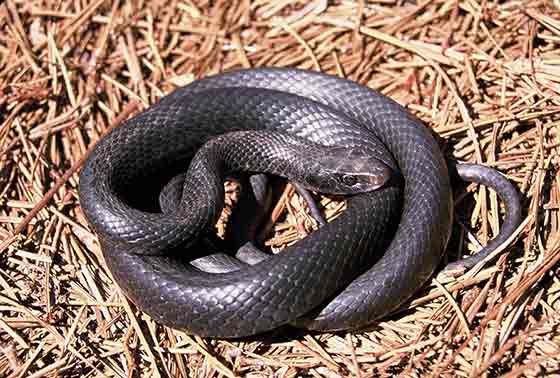Is it venomous? Identify what species.
Whether it’s venomous, of course, is the concern or fear underlying most of the questions. Chances are it’s not. Only six of the 46 species native to Georgia are venomous and only one – the copperhead – usually thrives in suburban areas, which is where the majority of Georgians live.
“While at least one of Georgia’s six species of venomous snakes could be found in each county in the state, seldom are they the most common species encountered,” Sollenberger said.
What should you do, or not do, if you see a snake?
Use caution around any unidentified snake. For more on Georgia’s snakes, visit georgiawildlife.com/georgiasnakes. Also, “Amphibians and Reptiles of Georgia” (University of Georgia Press) is a comprehensive reference.
• You can try to identify it from a distance. Resources such as georgiawildlife.com/georgiasnakes, which includes DNR’s “Venomous Snakes of Georgia” brochure, can help.
• Do not attempt to handle the snake. Give it the space it needs.
• Remember that snakes are predators that feed on rodents, insects and even other snakes. There is no need to fear non-venomous snakes. Also, Georgia’s native non-venomous species are protected by state law, and the imperiled eastern indigo snake is federally protected.
• If a clearly identified venomous snake is in an area where it represents a danger to people or pets, consult georgiawildlife.com/nuisancewildlife for a list of private wildlife removal specialists. Most bites occur when a snake is cornered or captured, and defending itself.
Non-venomous snakes such as scarlet kingsnake, eastern hognose and watersnake species are frequently confused with their venomous counterparts – coral snakes, rattlesnakes and water moccasins, respectively. While pit vipers, which include all venomous species native to Georgia except for coral snakes, are often identified by their broad, triangular-shaped heads, many non-venomous snakes flatten their heads when threatened and may have color patterns similar to venomous species.
SNAKE INSIGHTS
• Benefits: While some snakes eat rodents and even venomous snakes, others prey on creatures some Georgians also many not want near their homes. Brown and red-bellied snakes, for example, feed on snails and slugs, the bane of gardeners. Crowned snake species primarily eat centipedes.
• Baby snakes? Snakes such as earth and brown snake species are small and homeowners occasionally mistake them as juveniles. The common concern here: Are the parents nearby? Yet while some species are live-bearers and some are egg-bearers, snakes do not exhibit parental care. If there are parents, they are not watching over their offspring.
• Prevention: To reduce the potential for snakes near your home, remove brush, log piles and other habitat features that attract mice, lizards and other animals on which snakes prey.
HELP CONSERVE WILDLIFE
From eastern indigo snakes to bald eagles, DNR’s Wildlife Conservation Section works to conserve rare and other Georgia wildlife not legally fished for or hunted, as well as rare plants and natural habitats. The agency depends primarily on fundraisers, grants and contributions. That makes public support key.
5 way Georgians can help by supporting the state’s Nongame Wildlife Conservation Fund.
• Buy a DNR eagle or new monarch butterfly license plate, or renew one of the older plate designs, including the hummingbird. Most of the fees are dedicated to wildlife. Upgrade to a wild tag for only $25! Details at georgiawildlife.com/licenseplates.
• Donate at gooutdoorsgeorgia.com. Click “Licenses and Permits” and log in to give. (New customers can create an account.) There’s even an option to round-up for wildlife.
• Contribute to the Georgia Wildlife Conservation Fund when filing state income taxes – line 30 on form 500 or line 10 on form 500EZ. Giving is easy and every donation helps.
• Donate directly to the agency. Learn more at georgiawildlife.com/donations.
• Purchase a hunting or fishing license. A one-day, $5 hunting/fishing license returns to Georgia wildlife that fee plus about $45 in federal excise taxes paid by hunters and anglers nationwide.
Visit georgiawildlife.com/conservation/annualreport to see how your support is put to work for wildlife.


